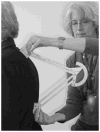Increasing kyphosis predicts worsening mobility in older community-dwelling women: a prospective cohort study
- PMID: 21198460
- PMCID: PMC3696343
- DOI: 10.1111/j.1532-5415.2010.03214.x
Increasing kyphosis predicts worsening mobility in older community-dwelling women: a prospective cohort study
Abstract
Objectives: To determine whether increasing kyphosis angle was independently associated with poorer mobility as measured according to the Timed Up and Go Test (TUG), after controlling for other established risk factors.
Design: Prospective cohort study.
Setting: Eleven clinical centers in the United States.
Participants: Two thousand seven hundred seventy-seven women aged 55 to 80 randomized to the placebo arms of the Fracture Intervention Trial, a randomized controlled trial of the effect of alendronate on risk for osteoporotic fractures.
Measurements: The primary predictor was change in kyphosis angle, measured using the Debrunner Kyphometer; the outcome was change in mobility, measured as performance time on the TUG. Covariates were baseline age, kyphosis angle, body mass index (BMI), self-reported health status, grip strength, change in total hip bond mineral density (BMD), and number of vertebral fractures over a mean of 4.4 years.
Results: Greater kyphosis angle predicted longer mobility performance times (P<.001), independent of other significant predictors of worsening mobility including age, baseline kyphosis, health status, grip strength, BMI, change in hip BMD, and new vertebral fractures. TUG performance times increased by 0.02 seconds (95% confidence interval (CI)=0.01-0.03) for every 5° increase in kyphosis angle, more than the increase in mobility time of 0.01 seconds (95% CI=0.005-0.03) over 1 year observed in this cohort.
Conclusion: Increasing kyphosis angle is independently associated with worsening mobility. Interventions are needed to prevent or reduce increasing kyphosis and mobility decline.
© 2010, Copyright the Authors. Journal compilation © 2010, The American Geriatrics Society.
Conflict of interest statement
Figures
References
-
- Balzini L, Vannucchi L, Benvenuti F, et al. Clinical characteristics of flexed posture in elderly women. J Am Geriatr Soc. 2003;51:1419–1426. - PubMed
-
- Sinaki M, Brey RH, Hughes CA, et al. Balance disorder and increased risk of falls in osteoporosis and kyphosis: Significance of kyphotic posture and muscle strength. Osteoporos Int. 2005;16:1004–1010. - PubMed
-
- Ryan SD, Fried LP. The impact of kyphosis on daily functioning. J Am Geriatr Soc. 1997;45:1479–1486. - PubMed
-
- Hirose D, Ishida K, Nagano Y, et al. Posture of the trunk in the sagittal plane is associated with gait in community-dwelling elderly population. Clin Biomech. 2004;19:57–63. - PubMed
-
- Schenkman M, Shipp KM, Chandler J, et al. Relationships between mobility of axial structures and physical performance. Phys Ther. 1996;76:276–285. - PubMed
Publication types
MeSH terms
Grants and funding
LinkOut - more resources
Full Text Sources


